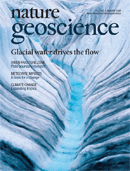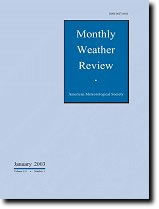
Numerical weather prediction (NWP) uses mathematical models of the atmosphere and oceans to predict the weather based on current weather conditions. Though first attempted in the 1920s, it was not until the advent of computer simulation in the 1950s that numerical weather predictions produced realistic results. A number of global and regional forecast models are run in different countries worldwide, using current weather observations relayed from radiosondes, weather satellites and other observing systems as inputs.
The Cooperative Institute for Research in the Atmosphere (CIRA) is a scientific research institution at Colorado State University (CSU) that operates under a cooperative agreement with the National Oceanic and Atmospheric Administration (NOAA) Office of Oceanic and Atmospheric Research (OAR) and the National Environmental Satellite, Data, and Information Service (NESDIS). Atmospheric research at CIRA focuses on augmenting operational meteorology with advanced techniques in satellite observations and retrievals, numerical modeling and computational techniques, and data analysis, visualization, and storage. Along with NOAA, CIRA also partners with the National Science Foundation (NSF), the National Aeronautics and Space Administration (NASA), the National Park Service (NPS), and the Department of Defense (DoD).

Ensemble forecasting is a method used in or within numerical weather prediction. Instead of making a single forecast of the most likely weather, a set of forecasts is produced. This set of forecasts aims to give an indication of the range of possible future states of the atmosphere. Ensemble forecasting is a form of Monte Carlo analysis. The multiple simulations are conducted to account for the two usual sources of uncertainty in forecast models: (1) the errors introduced by the use of imperfect initial conditions, amplified by the chaotic nature of the evolution equations of the atmosphere, which is often referred to as sensitive dependence on initial conditions; and (2) errors introduced because of imperfections in the model formulation, such as the approximate mathematical methods to solve the equations. Ideally, the verified future atmospheric state should fall within the predicted ensemble spread, and the amount of spread should be related to the uncertainty (error) of the forecast. In general, this approach can be used to make probabilistic forecasts of any dynamical system, and not just for weather prediction.
Data assimilation is a mathematical discipline that seeks to optimally combine theory with observations. There may be a number of different goals sought – for example, to determine the optimal state estimate of a system, to determine initial conditions for a numerical forecast model, to interpolate sparse observation data using knowledge of the system being observed, to set numerical parameters based on training a model from observed data. Depending on the goal, different solution methods may be used. Data assimilation is distinguished from other forms of machine learning, image analysis, and statistical methods in that it utilizes a dynamical model of the system being analyzed.

Joseph Smagorinsky was an American meteorologist and the first director of the National Oceanic and Atmospheric Administration (NOAA)'s Geophysical Fluid Dynamics Laboratory (GFDL).

The Weather Research and Forecasting (WRF) Model is a numerical weather prediction (NWP) system designed to serve both atmospheric research and operational forecasting needs. NWP refers to the simulation and prediction of the atmosphere with a computer model, and WRF is a set of software for this. WRF features two dynamical (computational) cores, a data assimilation system, and a software architecture allowing for parallel computation and system extensibility. The model serves a wide range of meteorological applications across scales ranging from meters to thousands of kilometers.

A tropical cyclone is a rapidly rotating storm system characterized by a low-pressure center, a closed low-level atmospheric circulation, strong winds, and a spiral arrangement of thunderstorms that produce heavy rain and squalls. Depending on its location and strength, a tropical cyclone is referred to by different names, including hurricane, typhoon, tropical storm, cyclonic storm, tropical depression, or simply cyclone. A hurricane is a strong tropical cyclone that occurs in the Atlantic Ocean or northeastern Pacific Ocean, and a typhoon occurs in the northwestern Pacific Ocean. In the Indian Ocean and South Pacific, comparable storms are referred to as "tropical cyclones". In modern times, on average around 80 to 90 named tropical cyclones form each year around the world, over half of which develop hurricane-force winds of 65 kn or more. Tropical cyclones carry heat and energy away from the tropics and transport it towards temperate latitudes, which plays an important role in regulating global climate.

Climate Dynamics is a peer-reviewed scientific journal published by Springer Science+Business Media. It covers all aspects of the dynamics of global climate systems, including analytical and numerical modeling research on the structure and behavior of the atmosphere, oceans, cryosphere, biomass, and land surface as interacting components of the dynamics of global climate. The journal also publishes reviews and papers emphasizing an integrated view of the physical and biogeochemical processes governing climate and climate change.
Roger Willis Daley was a British meteorologist known particularly for his work on data assimilation.

Nature Geoscience is a monthly peer-reviewed scientific journal published by the Nature Publishing Group. The Chief Editor is Tamara Goldin, who took over from Heike Langenberg in February 2020. It was established in January 2008.

Dr. André Robert was a Canadian meteorologist who pioneered the modelling the Earth's atmospheric circulation.

Eugenia Enriqueta Kalnay is an Argentine meteorologist and a Distinguished University Professor of Atmospheric and Oceanic Science, which is part of the University of Maryland College of Computer, Mathematical, and Natural Sciences at the University of Maryland, College Park in the United States.
Reviews of Geophysics is a quarterly peer-reviewed scientific journal published by Wiley-Blackwell on behalf of the American Geophysical Union. The current editor-in-chief is Fabio Florindo.

The history of numerical weather prediction considers how current weather conditions as input into mathematical models of the atmosphere and oceans to predict the weather and future sea state has changed over the years. Though first attempted manually in the 1920s, it was not until the advent of the computer and computer simulation that computation time was reduced to less than the forecast period itself. ENIAC was used to create the first forecasts via computer in 1950, and over the years more powerful computers have been used to increase the size of initial datasets and use more complicated versions of the equations of motion. The development of global forecasting models led to the first climate models. The development of limited area (regional) models facilitated advances in forecasting the tracks of tropical cyclone as well as air quality in the 1970s and 1980s.

The Meteorologische Zeitschrift is a bimonthly international peer-reviewed open access scientific journal covering research in meteorology and climatology. All papers published since 2000 are in English language. The journal was established in 1866 by the Österreichische Gesellschaft für Meteorologie and is one of the oldest journals in the field. In 1884 a similar journal was established by the Deutsche Meteorologische Gesellschaft. The two journals merged in 1886 and existed until 1944. After being published separately in East and West Germany after 1945, the journal was reestablished in 1992 as a joint publication of the Austrian, Swiss, and German Meteorological Societies and is published by Borntraeger Science Publishers.
Advances in Atmospheric Sciences is a bimonthly peer-reviewed scientific journal co-published by Springer Science+Business Media and Science Press. It covers research on the dynamics, physics and chemistry of the atmosphere and oceans, including weather systems, numerical weather prediction, climate dynamics and variability, and satellite meteorology. It was established in 1984. The editors-in-chief are Mu Mu, Junji Cao, and Ming Xue. According to the Journal Citation Reports, the journal has a 2020 impact factor of 3.158.
The Quarterly Journal of the Royal Meteorological Society is a peer-reviewed scientific journal of meteorology published eight times per year. It was established in 1871 as Bibliography of Meteorological Literature, obtaining its current name in 1873. It is published by Wiley-Blackwell on behalf of the Royal Meteorological Society.
Meteorological Applications is a peer-reviewed scientific journal of meteorology published four times per year since 1994. It is published by John Wiley & Sons on behalf of the Royal Meteorological Society.











